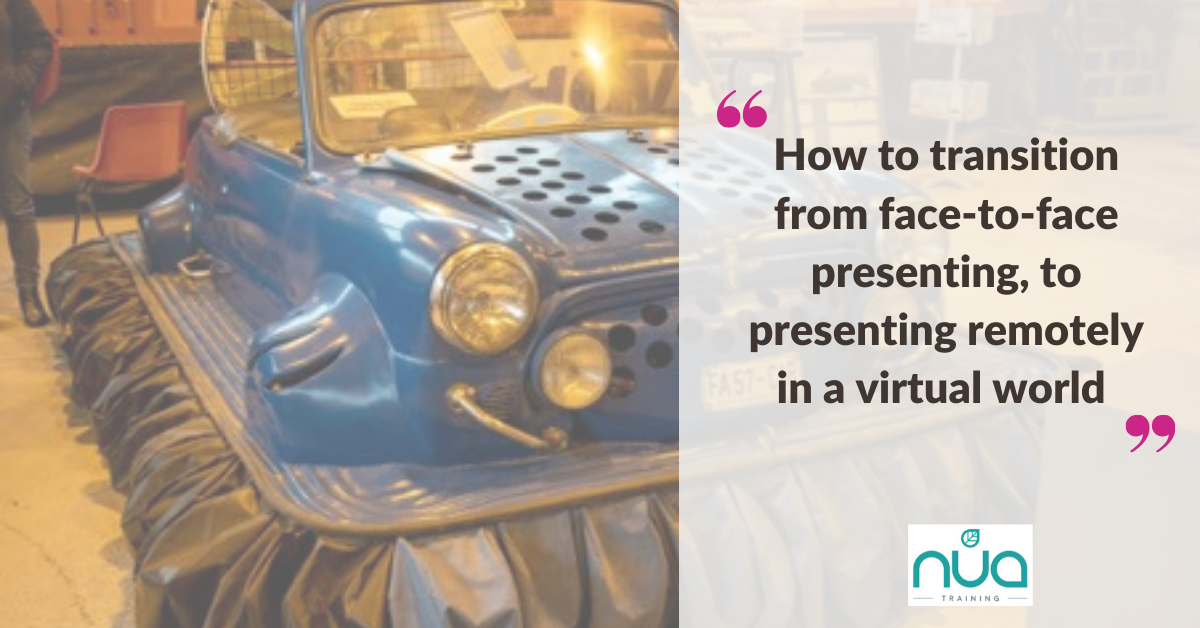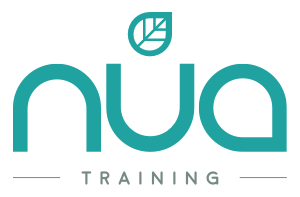
Most of us can drive a car.
But what if you had to fly a hovercraft. A hovercraft is unlike any other vehicle, despite the apparent similarities above. The best analogy is trying to drive a car on a sheet of wet ice on a windy day. The brakes don’t work, and the steering has little effect!
But in a few hours, you’ll have the hang of it and be flying around.
So, when you have to transition from face-to-face presenting, to presenting remotely in a virtual world, this is also probably going to be a new or under-developed skill and can be a nerve-wracking experience, even for the most accomplished of presenters.
It’s different from delivering face-to-face presentations. Presenting virtually to a room of people with no feedback, who can easily mute the call or walk away from the screen takes the importance of engagement to a whole new level.
But it’s not totally different. At Nua Training we have a number of trainers who are experts in virtual presenting.
Here’s our Top 5 top tips to help you transition to presenting virtually:
1 Preparation
Whether you’re presenting online, or face-to-face you still need to do all the preparation work. In particular;
- Key message – be really clear with your audience about what the point of your talk/presentation is. The key message is the cornerstone of your presentation – it provides your focus. In a virtual world this is even more important, as you may have no visual clues that the audience don’t ‘get’ or understand your message.
- Audience first – tailor each presentation to the audience. If you are hosting a webinar then you can see who has signed up in advance and can ask people to submit questions beforehand.
- Location, location, location – think about where you are going to present. A plain grey wall is pretty uninspiring. A plant growing out of the top of your head just looks silly. Go for the ‘professionally personal and interesting’ look, but not too distracting, as you want to minimise ‘background noise’.
- Practice makes perfect – and most important of all, rehearse, rehearse and rehearse. By giving yourself plenty of time to practice, you can become more familiar with the content and tech, and plan for any mishaps.
2 Visuals
The medium of the screen changes the way an audience takes in information from slides. The trap is also thinking you can just give the same talk that you’d previously prepared for a face-to-face presentation – this simply doesn’t work.
As a participant, you can read faster than the presenter can speak. You may really struggle to read the slides and understand all the content and miss what the presenter’s saying. Try to reduce the level of text used so you don’t create sensory overload. One way of doing this is by creating slide builds to drip-feed information, so there isn’t too much to take in at one time.
Also, what works well on a big screen doesn’t always work well and on a smaller one. So, think carefully about what will resonate best with your audience.
3 Delivery
With a reduced range of sensory stimulation, presenting virtually enhances the importance of audio, so voice-tone, pitch and pace become a lot more important.
Warm up like an actor, do some vocal and facial exercises to warm all the muscles up. Be very conscious of when you want to change your tone for emphasis or signify a change of topic, just as they do on news programmes.
And don’t forget to PAUSE ……………… after a key point. Silence is under-used in this medium, but it is incredibly powerful.
4 Technology
Make technology your friend. Things may well go wrong, so have back-ups ready, such as another computer and an ethernet cable.
There’s also handy functionality in a number of the conferencing packages. For example, Zoom’s breakout rooms, whiteboard and annotation tools are particularly good for engaging audiences and group discussion. Tools such as Slido and Mentimeter bring additional options for real time engagement through live Q&A, quizzes and polls.
You can also use the technology to record yourself when you’re rehearsing and get others to give you feedback to fine tune your content and delivery.
5 Engagement
The distractions in the virtual world are different from those in a face to face presentation. Notifications may be popping up on screens, and people may be listening in whilst also working, or they may even be tuning in whilst doing house chores! In the real world few people would actually walk out of an uninspiring presentation, but they can easily do that when a presentation is delivered remotely via video. As a presenter it is much tougher to keep people’s attention in the virtual world.
To overcome these limitations, the key is to keep people involved and consciously present in the session:
- Try to talk with your audience, not at them. Encourage as much interaction as you can throughout using simple techniques such as calling out people’s names, getting a show of hands, asking rhetorical or pre-emptive questions.
- Stories are really powerful. Going back to our ancestors, that was how information was passed down through generations. We are hardwired to remember stories.
- Your body language is an often overlooked way of engaging a virtual audience. Use your hands to add emphasis to points, smile to make people feel welcome, and look into camera to create a connection.
Good presentation skills are essential in business and working remotely has simply added a new dimension to things.
Get in touch with us today at info@nuatraining.co.uk for more insights on presenting and to find out more about our range of training and coaching services. Or sign up for our Presenting with Impact, Virtually course with our two time TEDx speaker here to get your virtual presentations flying.
